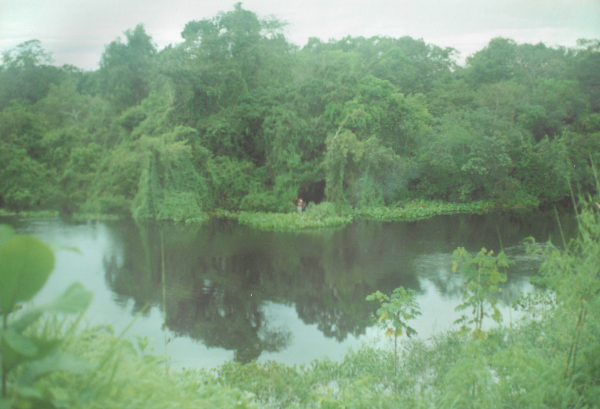The River Folk
The last time I was out
with the River Folk I had a speculation, which I’d like to call a
predilection.
I had the distinct
impression, or was it just my imagination, that a
fellow and a lady had some history together and … that he wanted for
there to
be a future. That being said, she sitting on my knee presented a
particular
type of problem for him, and he began to take my measure.
He said to me, “You’re
sitting there looking pretty calm, cool, and collected.”
To which I replied,
“When you’ve seen some of the things I’ve seen, you
learn to not get too excited.”
I thought of a
jungle cat from my memory—all those years ago.
I was on the
Zaramanu River. The Zaramanu puts into the Manupare River,
which joins with the Manurimi to form the Sena. The Sena is a tributary
of the
Madre de Dios, which joins the Rio Beni, which joins the Madeira, which
is a
tributary to the mighty Amazon River. You just can’t get any deeper
into the
rainforest than this; all compass points now led equally to the outside
world.
I’d never been anyplace
so remote. So … hidden away in time.
The people that live
here, where the only roads are the footpaths along
the rivers, and the rivers themselves, are called the Araona. They are
a people
of the mist. Their ancestors had, for generations, been captured and
traded as
slaves to work the rubber plantations. Two hundred and two aught years
ago,
some families escaped the realms of the Rubber Barons, and brutal
slavery. The
Araona are their descendants. They too, had good reason to be wary this
night.
Here, near the banks of
the river, I set out to work. With a window of
satellites, in the days before a full GPS constellation, between
midnight and
four in the morning, I levelled up my equipment at the edge of camp. A
single
fisher bat flew overhead on its way to the water, wings drumming in
time to the
multitude of the birds and the insects. The hour before dawn is, by far
the
noisiest time in the jungle.
I was alone in the dark,
at the edge of the light, when I heard a
jungle cat screeching nearby and the forest grew silent. I pulled my
knife from
its sheath and I waited.
Tom cat was hunting.
Hunting me.

Footer
The South American Puma is similar in appearance to our
Mountain Lion,
but much thicker and heavier. A beautiful, graceful animal! Very
formidable. Endangered. I told the crew at breakfast the next morning and they just
laughed and said, "Oh, no. It's a monkey that makes that sound!" There
is a monkey in Bolivia which makes a similar sound and they call
sometimes, but I knew the difference and when you know that ... they're
really not similar at all. "I know what I heard," I said. Two days
later the cat, a male, was brought in to camp strung on a pole. It was
killed by local Amazonians (Pacahuara?) and maybe with a poison arrow or trap for we
never heard a shot. It was said the warriors were protecting us,
protecting their families.
As the original (reactive) picture is relevant, adding both dimention and an element of
truth, it is linked below. Please note I did not say
I killed the animal, only that I was prepared to defend myself: Look at the
cat and imagine it alive. Big, sinuous, 12 foot long with 2 inch claws.
If the cat had attacked, if I had run, I wouldn’t be lounging around
drinking coffee from a cup two days later looking, 'pretty calm, cool,
and collected.' Think about it. What would you do? Would you fight or
flee or would you lay down and sacrifice yourself to the noble cause?
Puma.jpeg
¹
Adapted in part from the novel, 'The Spirit Wolf.'
© Stephen Stewart 2022
FOOT & CHAIN™


